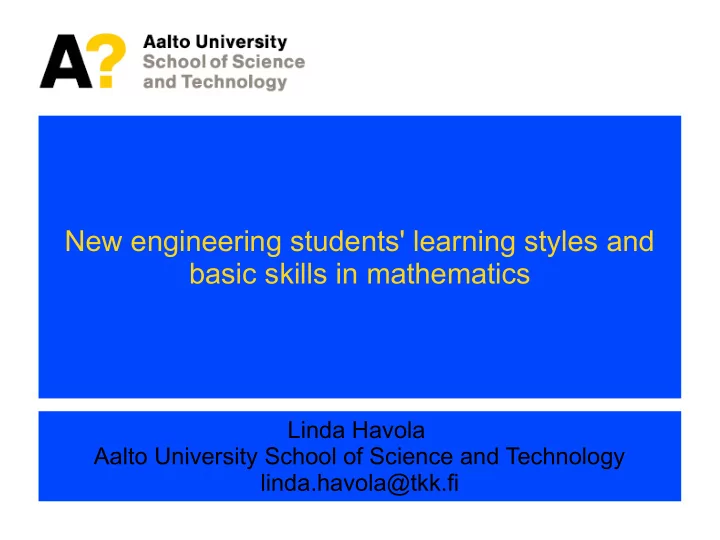

New engineering students' learning styles and basic skills in mathematics Linda Havola Aalto University School of Science and Technology linda.havola@tkk.fi
Introduction ● This study is related to a project which aims to increase the number of students passing compulsory engineering mathematics courses. ● Problems are, for example, first year students' varying skills in mathematics and passivity in their studies. ● We would like them to adopt more effective learning strategies. ● Hence is necessary to understand students' learning processes better. Linda Havola linda.havola@tkk.fi
Research questions Research questions What are the fundamentals affecting learning outcomes in mathematics for new students who come to our university? ● What kind of learning styles do new students have? ● What differences, if any, there are between engineering students and, e.g., communication science students? ● What starting skills new students have in mathematics? ● What were the most difficult topics in the high school mathematics for new students? Linda Havola linda.havola@tkk.fi
Basic skill's test Basic skill's test ● All new students (N=704 in 2008, N=843 in 2009 and N=833 in 2010) made the basic skill test in the autumns 2008, 2009 and 2010. ● The test problems were originally created in Tampere University of Technology (TUT). ● In Aalto University the test was implemented by using Automatic assessment system STACK (Sangwin 2003). ● It included 16 randomized questions covering the high school topics considered to be the most crucial. Linda Havola linda.havola@tkk.fi
Distribution of the results Distribution of the results Black=2010 White=2009 Linda Havola linda.havola@tkk.fi
Distribution of the points of each exercise in 2010 Distribution of the points of each exercise in 2010 ● Linda Havola linda.havola@tkk.fi
Learning styles questionnaire Learning styles questionnaire ● In autumns 2009 and 2010 we sent a learning styles questionnaire to all students who participated the basic skill test. ● The number of responses was 222 (26%) in 2009 and 432 (52%) in 2010. ● The questionnaire was based on R. Felder's Index of Learning Styles Questionnaire (Felder 2001). ● It included 44 questions about four different learning style dimensions. Linda Havola linda.havola@tkk.fi
Dimensions of the learning styles Dimensions of the learning styles Linda Havola linda.havola@tkk.fi
Results of the learning styles questionnaire in Results of the learning styles questionnaire in 2009 2009 ● We divided the results of each dimension into five categories 1-5. An example from active/reflective scale 1: strongly reflective 2: moderately reflective 3: balanced 4: moderately active 5: strongly active ● We compared the results to the results of the communication science students in University of Tampere (UTA) (Vainionpää, 2006). Linda Havola linda.havola@tkk.fi
Learning styles questionnaire Learning styles questionnaire Active/reflective scale Active/reflective scale ● Roughly normally Active/reflective scale 140 distributed 120 ● Mean 3.13, std=0.79 ● UTA: mean 3.25, 100 std=0.74 80 60 40 20 0 Strongly reflective Balanced Strongly active Linda Havola linda.havola@tkk.fi
Learning styles questionnaire Learning styles questionnaire Sensing/intuitive scale Sensing/intuitive scale ● Negatively skewed Sensing/intuitive scale Active/reflective scale 140 90 ● Mean 3.96, std=0.85 80 120 ● UTA: mean 3.00, 70 std=0.90 100 60 80 50 40 60 30 40 20 20 10 0 0 Strongly intuitive Strongly reflective Balanced Balanced Strongly sensing Strongly active Linda Havola linda.havola@tkk.fi
Learning styles questionnaire Learning styles questionnaire Visual/verbal scale Visual/verbal scale ● Negatively skewed Sensing/intuitive scale Active/reflective scale Visual/verbal scale 90 90 140 ● Mean 3.79, std=0.95 80 80 120 ● UTA: mean 3.51, 70 70 60 std=1.00 100 60 50 80 50 40 40 60 30 30 40 20 20 10 20 10 0 0 Strongly verbal Balanced Strongly visual 0 Strongly intuitive Strongly reflective Balanced Balanced Strongly sensing Strongly active Linda Havola linda.havola@tkk.fi
Learning styles questionnaire Learning styles questionnaire Sequential/global scale Sequential/global scale ● Roughly normally Sequential/global scale Sensing/intuitive scale Active/reflective scale Visual/verbal scale 90 140 90 140 distributed 80 80 120 120 ● Mean 3.10, std=0.76 70 70 60 ● UTA: mean 2.54, 100 100 60 50 std=0.83 80 80 50 40 40 60 60 30 30 40 40 20 20 10 20 20 10 0 0 Strongly verbal Balanced Strongly visual 0 0 Strongly intuitive Strongly reflective Strongly global Balanced Balanced Balanced Strongly sequential Strongly sensing Strongly active Linda Havola linda.havola@tkk.fi
Conclusions Conclusions ● According to the results of the basic skill's test of mathematics students have many gaps in mathematics. ● Difficult topics are for example symbolic fractions, logarithms and trigonometric expressions ● More time should be dedicated to these difficult topics in high school and university mathematics. ● No strong correlation was found between the results of the basic skill test and learning styles questionnaire. Linda Havola linda.havola@tkk.fi
Conclusions Conclusions ● According to earlier studies engineering students tend to be more active, sensing, visual and sequential learners (for example Booth, 2008). ● Our results show that engineering students in Aalto University sensing and visual learners. However in other scales results are normally distributed. ● Mathematics teaching in Aalto University is predominantly verbal or visual presentation of verbal information. Teachers should thus use more visual elements in their teaching. Linda Havola linda.havola@tkk.fi
Thank you! Linda Havola linda.havola@tkk.fi
Recommend
More recommend